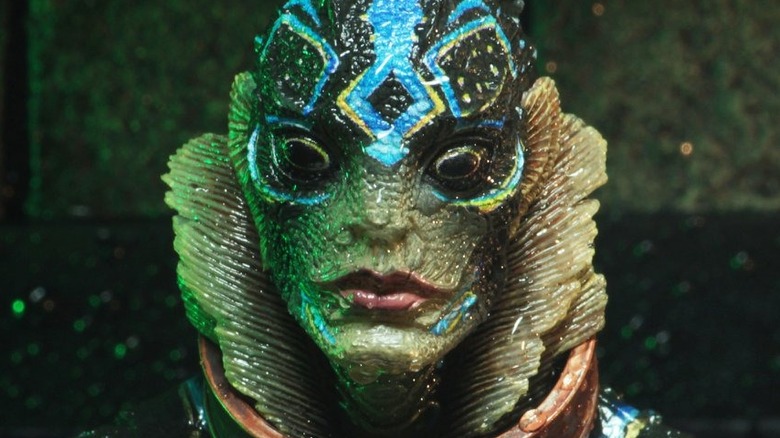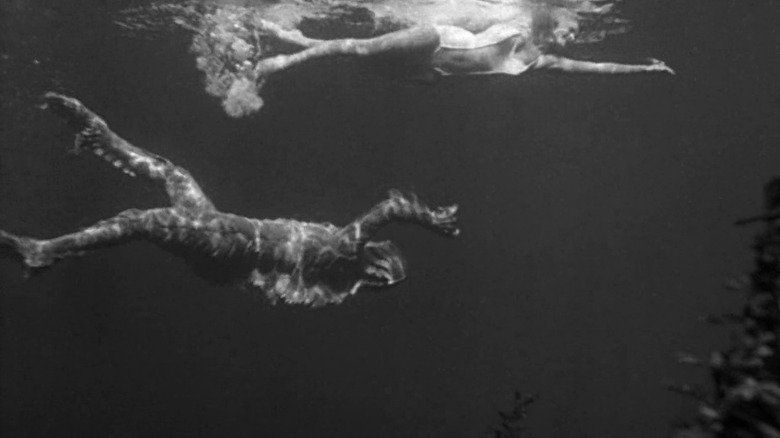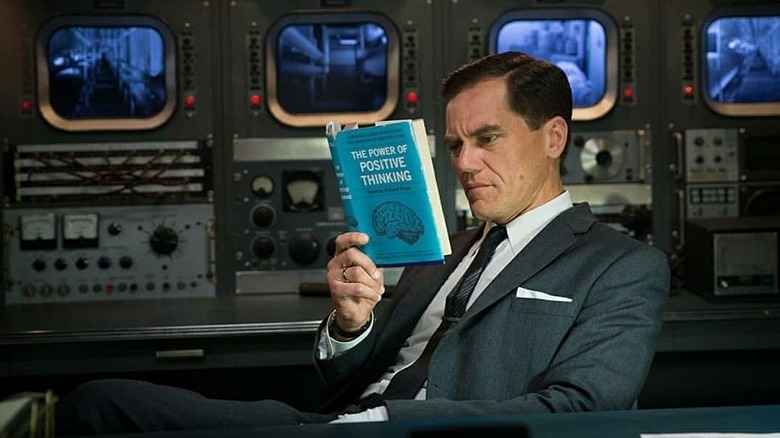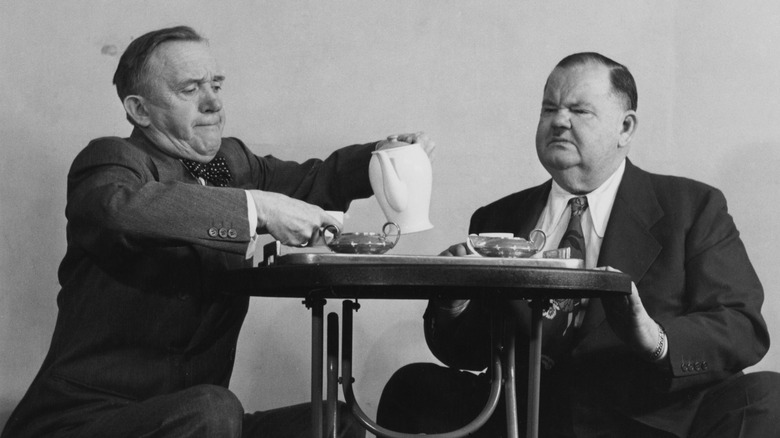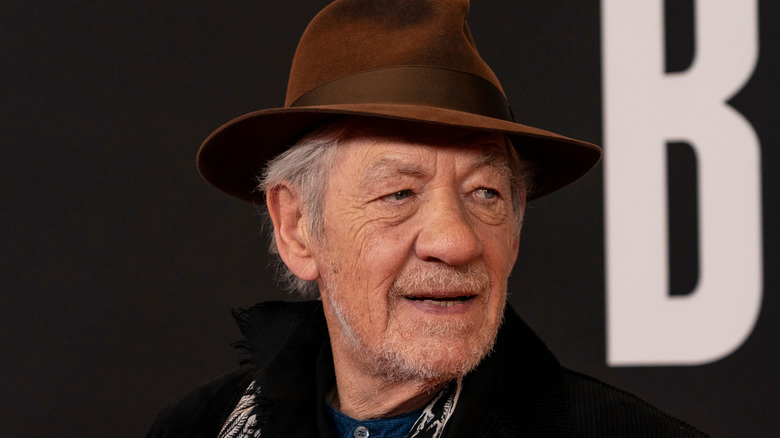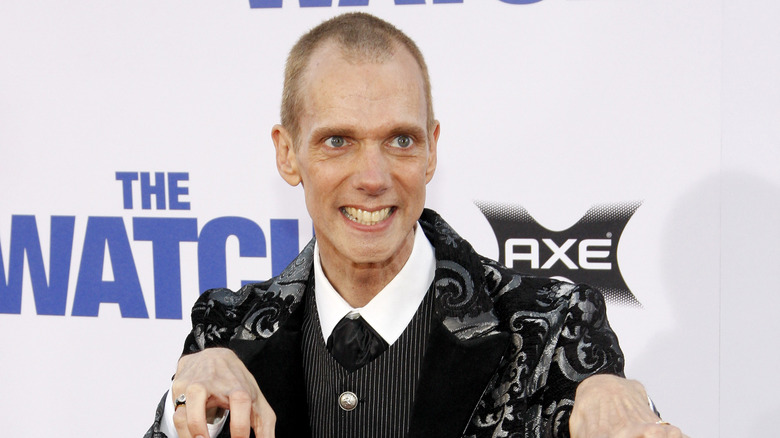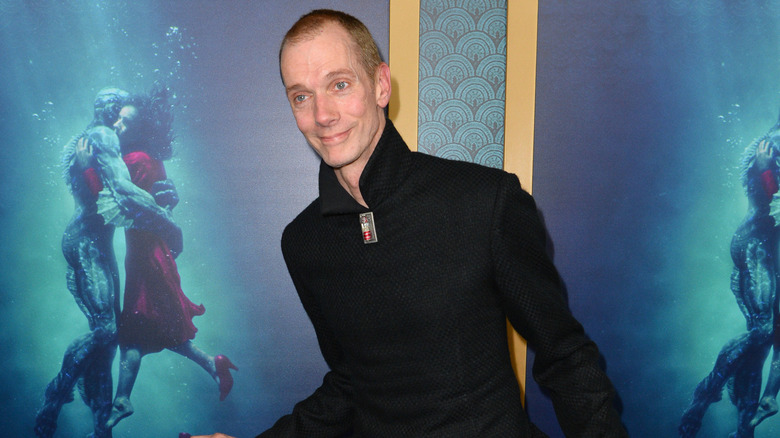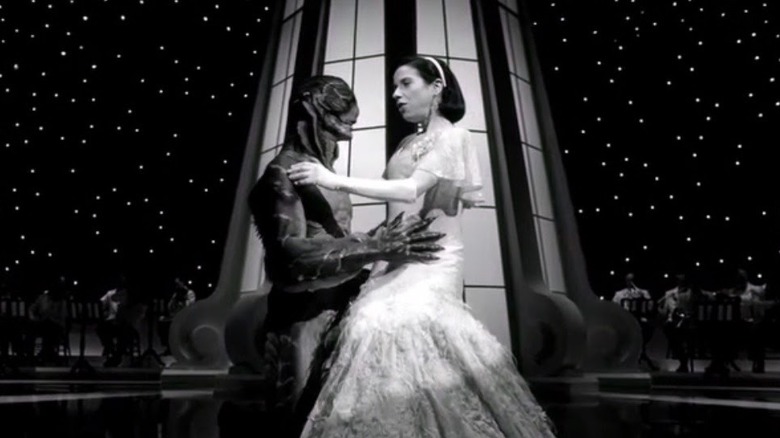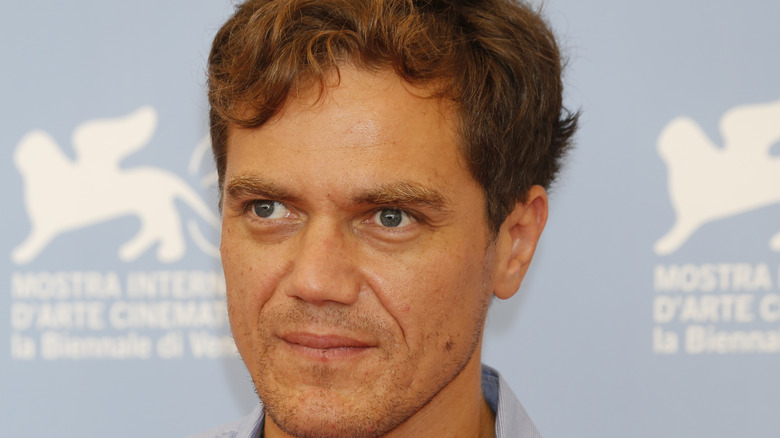The Shape Of Water Details That Will Make You Appreciate The Oscar Winner Even More
"The Shape of Water" was a milestone in director Guillermo del Toro's career. Prior to the release of the film in 2017, del Toro was considered a more niche filmmaker with a loyal contingent of fans in the horror and fantasy genres. With "The Shape of Water," del Toro experienced a surge in worldwide popularity, the movie going on to be considered one of the best films of the year.
Set in the early 1960s, "The Shape of Water" follows a lonely mute janitor named Elisa (Sally Hawkins) at a secretive, high-security government facility. Happening across a strange creature brought into the facility for study (Doug Jones), Elisa slowly falls in love with the creature and begins plotting ways to help escape it from its confinement.
The success enjoyed by "The Shape of Water" is clear, culminating in overwhelmingly positive reviews, a fantastic financial performance at the box office, and 13 nominations at the Academy Awards (four of which — including best picture — it ended up winning). As widely celebrated as the movie was, there is still plenty to know about the film's background information, such as its primary cinematic influences and del Toro's working relationship with the cast and crew. Here are some of the most interesting facts about "The Shape of Water."
The movie was heavily inspired by The Creature from the Black Lagoon
Guillermo del Toro has a deep love and appreciation for all things macabre that he regularly channels into his films. This appreciation dates back all the way to del Toro's childhood, with del Toro stating that the original impetus for "The Shape of Water" came while he was watching "The Creature from the Black Lagoon" as a boy.
As he told the Los Angeles Times, the idea for "The Shape of Water" was born out of the emotional reaction he had watching the 1954 horror movie when he was six years old. In particular, he found inspiration in the scene where the titular creature is swimming beneath Julie Adams' lead heroine. Reflecting on this scene, del Toro said, "I thought, 'This is the most poetic thing I'll ever see.' I was overwhelmed by the beauty... I thought, 'I hope they end up together.'" At a British Film Institute Screen Talk, del Toro also said he found himself relating more to the creature than he did to the human protagonists, who were viewed as being outsiders encroaching on the creature's natural habitat.
Unsurprisingly, several elements from "The Creature from the Black Lagoon" were used as inspiration for del Toro's films. For example, the physical design of del Toro's Amphibian Man is strikingly similar to the Gill-man's appearance in "Black Lagoon." The fact that the Amphibian Man was found in a South American river and was transported to America also has a heavy basis in the original plot line of "Black Lagoon."
Guillermo del Toro pitched the film to star Sally Hawkins in a very unique way
Guillermo del Toro has said that he wrote many of the film's lead roles with certain actors in mind — specifically writing the part of Elisa for Sally Hawkins. Impressed with her performances in "Fingersmith" and "Happy-Go-Lucky," del Toro felt Hawkins was the perfect choice to play someone of such timidity and natural beauty as Elisa, yet still retaining a sense of realism in her performance. "She had a luminosity and a power, but at the same time, you can see her on a bus. She was a normal person. Just normally beautiful in a way that's not standard," del Toro said at his BFI Screen Talk.
When it came time to present the story to Hawkins, though, del Toro broached the subject in a very interesting way. At his BFI appearance, del Toro said that he reluctantly agreed to attend a Golden Globes afterparty. While there, del Toro — who admitted he "hates" alcohol — drank "about 14 shots of tequila" with the encouragement of his friend, filmmaker Alfonso Cuarón.
As he was leaving the party, del Toro crossed paths with Hawkins. "So I'm leaving with my 14 shots of tequila in me, and I see Sally, and I go, 'Hey! I'm writing a movie for you where you fall in love with a fish!'" However, rather than being phased by this first encounter with del Toro, Hawkins responded enthusiastically — though del Toro later reflected, "I was drunk and it's not a movie that makes you sound less drunk."
Guillermo del Toro wanted the film to be the anti-Beauty and the Beast
When Guillermo del Toro first approached Sally Hawkins with the offer to star in the film, the two engaged in several talks about the nature of the story and the relationship between Hawkins' character and her aquatic love interest. As del Toro related in his BFI Screen Talk, he stated the main thing he wanted to convey was the idea that love is malleable, and can turn up in the most unexpected of places.
"The first thing I found was the idea of water being love. Because love, like water, has no shape. It can take the shape of whatever you pour it into," del Toro said at the panel. As a result, del Toro resolved to portray the natural relationship that forms between Elisa and the Amphibian Man, contrasting it sharply with other traditional love stories like "Beauty and the Beast."
In del Toro's eyes, the film central's message is about love and accepting significant others for who they are, not who you want them to be, as is the case with "Beauty and the Beast." As del Toro put it, "I wanted to do 'Beauty and the Beast' where Beauty is not a Disney princess and the Beast doesn't turn into a f***ing prince. Because I think love is loving who the other person is exactly... I thought it could be about embracing and loving the otherness." Because of this, he believed the creature and Elisa remaining just as they were at the start of the film was of paramount importance.
Strickland was designed as a subversion of '50s monster movie heroes
One of the first concepts Guillermo del Toro settled on for "The Shape of Water" was the idea of using the traditional hero archetype of '50s B-horror movies as the main antagonist for his film. As del Toro said at his BFI Screen Talk, "I wanted to make the straight guy — with the gun and the nice suit and the square jaw — the villain." Writing the part of Strickland with this notion in mind, it was this idea that most attracted Michael Shannon to the role.
In an interview with Vanity Fair, Shannon said that he and del Toro had long discussions about Strickland's character. Shannon told the magazine he was intrigued by the notion that, had the movie been made in the '50s, Strickland would've been the main hero — the handsome, well-off government agent who triumphs over the nefarious creature and wins the girl by the final credits.
"The inversion of that perception is interesting because it ultimately erodes the whole notion of heroes and villains," said Shannon. "Realistically, it's always so much more complicated than that." Shannon also said that he was impressed by del Toro's enthusiasm for the project in spite of his personal anxieties about the movie's potentially odd subject matter — another reason he agreed to star in the film.
Of the entire cast, Octavia Spencer was perhaps the most eager to work with del Toro
Many of the main roles in "The Shape of Water" were written with certain actors in mind, including the lead characters of Elisa and Strickland. In addition to those two, Guillermo del Toro wrote the part of Elisa's best friend, Zelda, for actor Octavia Spencer. While Sally Hawkins and Michael Shannon were both fairly enthusiastic about the project, Spencer seemed far more interested in the prospect of working with del Toro than any of her co-stars, signing on almost instantly.
As Spencer told Deadline, del Toro first approached Spencer at a casual "breakfast/lunch-type thing." In what was supposed to be a 30-minute conversation, del Toro and Spencer spoke with one another for the next three hours, del Toro only broaching the script for "Shape of Water" in the last five minutes of their meal. Spencer, a self-professed fan of del Toro's work, immediately said yes to the role of Zelda without bothering to read the script.
In an interview Daily Dead, Spencer said that she would've done virtually anything to ensure she had a part in del Toro's film. "I would have been a potted plant had he asked me to be in Michael Shannon's office in the background as a plant that comes to life. I would've done it to work with Guillermo," the actor said.
Octavia Spencer has said the script's prominent minority characters are what attracted her to the script
While Octavia Spencer's desire to work with Guillermo del Toro was what led her to signing on for the movie, she also said that the movie's script provided another thing that attracted her to the film. Given its period setting and main theme of "otherness," Spencer told the Gold Derby that she believed the film shed light on important issues in its historical presentation of the 1960s. Tying into those themes further, Spencer said she was drawn to the project because of it's inclusion and heavy emphasis on minority groups at the time.
By having the film's two main characters unable to speak, Spencer said the most prominent speaking parts revolved around Zelda and Giles — two characters whose voices were largely ignored throughout the '60s. "It's funny that he wrote two main characters who can't speak, and then the people he chooses to use as their voice are people who represent very disenfranchised groups, an African American woman and a closeted gay man," said Spencer.
In Spencer's eyes, it's this aspect of the script that helps underscore the movie's predominant theme of otherness, giving voices to people who were marginalized by society in the movie's historical time frame.
Guillermo del Toro prepared extensive biographies of each main character for the film
Guillermo del Toro's ambition for "The Shape of Water" led to the director taking a few more additional steps in regard to the background of the film. Thinking of complex backstories for each of the main characters, del Toro wrote biographies for each lead role in the film, as he revealed to The Playlist. These biographies covered everything from their past lives to the characters' more mundane behavioral characteristics, such as their favorite foods, TV shows, movies, and books. Uniquely, del Toro also included a section for each biography that contained a "secret no one knows about you," meant for that specific actor alone.
Once these biographies were completed, del Toro distributed them among the cast, allowing them to use the extra material for reference in their performance. The actors were free to use however much or as little of their biographies as they saw fit, with some of the cast relying on their biographies far more than others. Del Toro said that Richard Jenkins didn't use his biography at all, while Octavia Spencer, Michael Shannon, and Michael Stuhlbarg all heavily relied on them for their performance.
In Stuhlbarg's opinion, having such extensive knowledge about the daily life of his character allowed him to greatly understand the more minute aspects of his character. To add an additional layer of depth to Hoffstetler, Stuhlbarg even worked with del Toro to stock his character's apartment with things that he enjoys — such as stacks of Hoffstetler's favorite books.
Sally Hawkins studied silent comedy stars to prepare for her role
The idea of portraying a mute character is a daunting prospect for even the most talented actor. However, Sally Hawkins effectively portrayed every nuance of her character through a visual performance alone, expertly using her body language and facial expressions to convey emotion.
To more fully prepare for her performance, Hawkins looked back at the silent film stars of the 1910s and '20s, studying how their movements, faces, and body to tell a story visually rather than just vocally. To aid her in her research, del Toro told the Gold Derby that he gifted her a Blu-ray collection of films featuring influential comedians to base her performance on, including films starring Charlie Chaplin, Buster Keaton, Harold Lloyd, and the team of Oliver Hardy and Stan Laurel.
Regarding this collection of films, del Toro instructed Hawkins to closely analyze the performances of Laurel in particular, whom he felt Hawkins effectively channeled into her portrayal of Elisa. As del Toro saw it, "This guy [Laurel] can do a state of grace without conveying it verbally, and she studied them and her behavior is unlike any other character in the movie. No other actor does that."
Giles was written for Ian McKellen
As mentioned previously, most of the main characters in the film were written with specific actors in mind to portray them. While most of the actors del Toro eyed for a role went on to appear in the finished film, one notable exception was Ian McKellen, who Guillermo del Toro had initially planned to cast as Elisa's good friend, Giles.
Writing "The Shape of Water," del Toro told The Playlist that he looked to McKellen's portrayal of "Frankenstein" director James Whale in 1998's "Gods and Monsters" as a key source of inspiration for Giles' character in the film. Like McKellen's Whale, Giles was a once successful individual who had trouble acquiring steady work in his later life and is known to have a tumultuous romantic life as a gay man in Hollywood. Del Toro said that he found something "endearing" and "adorable" about McKellen's interpretation of Whale, and ended up basing Giles in part on the famous horror movie director.
Unfortunately, McKellen was unable to appear in the film, leading del Toro to reach out to Richard Jenkins instead. After reading the script, Jenkins told The Hollywood Reporter that he immediately agreed to appear in the film.
Guillermo del Toro originally wanted the film to be shot in black and white
With heavy influence taken from '50s horror, Guillermo del Toro originally considered shooting "The Shape of Water" in black and white, further alluding to its period setting and basis in '50s monster movies. In the movie's preliminary stages, del Toro told The Wrap, "I was of two minds. On one hand, I thought black and white would look luscious, but on the other hand, I thought it would look postmodern like I was being reflective rather than immersed."
Unfortunately, when it came time for del Toro to pitch the film to Fox Searchlight Pictures, they offered del Toro an ultimatum in regard to the film's budget. If del Toro were to shoot in color, Fox said the guaranteed budget for the film would be around $20 million; if he were to shoot in black and white, the budget would be under $17 million. Wanting the padded budget, del Toro agreed to make the film in color instead, saying bluntly, "That was honestly a battle I was expecting to lose."
Some of the movie's crew, like production designer Paul Austerberry, were apparently more receptive to the idea of using color over black and white, as Entertainment Weekly pointed out. However, del Toro remained indifferent, saying that his decision to shoot in color was to maintain studio relations rather than a genuine artistic desire to use color in his film. "It was one of those things that I knew I was not really interested in, but I knew I needed to appear reasonable," del Toro said.
It took three hours to get Doug Jones into costume
"The Shape of Water" makes use of several collaborators from Guillermo del Toro's past — most notably Doug Jones, the lead star in the film opposite Sally Hawkins, who plays the enigmatic Amphibian Man who Elisa falls in love with. Previously, Jones has worked with del Toro on "Mimic," both "Hellboy" films, "Pan's Labyrinth," and "Crimson Peak," all of which required him to wear heavy prosthetics and makeup for his characters.
When del Toro came to Jones with the idea for "The Shape of Water," Jones expressed some misgivings about the premise but maintained that his trust in del Toro ultimately won out. "I have not felt that kind of fear ever when being offered a movie... Boy, wow, on paper, you think 'this is ridiculous,'" Jones told NPR. Fortunately, the Amphibian Man proved to be a slightly less arduous makeup process for Jones, the crew needing around three hours to put the creature's suit onto Jones, and another 40 minutes to take it off.
Compared to Jones' earlier roles in "Pan's Labyrinth" and "Hellboy," Jones called the process much "kinder and gentler." However, he did run into an occasional problem in regards to using the restroom, with Jones usually wearing his costume for as long as 18 hours straight.
Doug Jones chose to portray the character as a Matador
Despite Doug Jones being doused in heavy amounts of makeup and prosthetics for the Amphibian Man, del Toro worked closely with Jones to ensure his performance was as top-notch as the other talents in the film. For example, Guillermo del Toro instructed Jones how to move his body and sell his performance more visually than vocally — much as Sally Hawkins did for the movie as well.
Jones told NPR that del Toro had a few key ideas when it came to his portrayal of the Amphibian Man. "He wanted to see no trace of human. He wanted to really see an ecosystem that came from another place, another world, another species. He wanted to see a heroic stance that would warrant why I was worshiped as a god in the Amazon," said Jones. As part of that, del Toro underscored the importance of the Amphibian Man having an air of "regalness" about him, as well as telling Jones to incorporate elements of a matador into his performance.
To figure out how to carry himself as the Amphibian Man, Jones went to a dance studio, developing the creature's stance and basic movements. For the matador aspect of the character, Jones modeled his movements after an actual bullfighter, walking as a real matador does in real life, leading with the hips and pelvis. "It's sexy and graceful all at the same time, and very athletic and very fearless... That's kind of what I did," said Jones.
Guillermo del Toro has named The Shape of Water his favorite movie that he's worked on
Since his feature-length debut with 1993's "Cronos," Guillermo del Toro has had a varied and diverse career. He's written and directed comic book adaptations, modern kaiju films, fairy tales set in the Spanish Civil War, and Gothic romances that are equal parts Edgar Allan Poe as they are Jane Austen. Many of his films have gone on to achieve critical or financial success, with "Pan's Labyrinth" winning multiple BAFTA and Academy Awards. As praised as some of his films have been in the past, del Toro has said that "The Shape of Water" is the movie he's proudest of.
In an interview with Collider, del Toro referred to the movie as the most personal artistic project he's ever worked on, saying, "It's my favorite movie that I've done." Del Toro went on to say, "It has an enormous heart. I've seen it 190 million times and I still cry in three or four moments in the movie."
Del Toro has said that the personal connection he feels to the film is largely due to its hopeful nature the movie presents about such topics as love. As del Toro put it, with how grim the world can be, having such a powerful and tender message at the heart of his film helped him form a greater connection with the movie. "I call it a 'fairytale for troubled times' because it's an ointment against the world, where we're waking up every morning with worse news," del Toro said.
The dance scene is an homage to a classic Fred Astaire and Ginger Rogers movie
One of the most remarkable scenes in "The Shape of Water" comes when Elisa imagines a complex dance number with the Amphibian Man that's meant to articulate her warm feelings for the creature. This scene is actually an homage to the 1936 musical comedy classic, "Follow the Fleet," starring Fred Astaire and Ginger Rogers in their fifth collaboration together. The scene takes place near the end of the movie, with Astaire and Rogers' characters meeting on top of a high-rise building at night, dancing to the song, "Let's Face the Music and Dance."
Not only does the dance number in "The Shape of Water" incorporate some of the same moves used by Astaire and Rogers, but the set design is taken almost straight from "Follow the Fleet," with only slight differences between the two sets. Rather than dancing above a city at night, "The Shape of Water" set incorporates lights that are meant to stand in for stars. Additionally, in Elisa's imagination, a tuxedo-clad band is playing orchestral music in the background to accompany the creature and Elisa's dance. Obviously, no such band is present in "Follow the Fleet."
Michael Shannon accidentally forgot to put Strickland's car in park during filming
While the filming schedule for "The Shape of Water" had the same amount of issues as any movie, one memorable incident that did crop up was an accident involving principal actor, Michael Shannon. The issue occurred when Shannon was filming a scene that required him to drive his character's vintage Cadillac. As Guillermo del Toro told The Hollywood Reporter, Shannon was meant to put the car in park before getting out and proceeding up a flight of stairs.
Unfortunately, Shannon told WENN that, because the car lacked the same dash light that modern cars have, he couldn't see that he hadn't placed the car in the park. As a result, the car — still in drive at this point — began rolling forward the minute he stepped out. Shannon tried to hop in and stop the car, but he was instead dragged forward, unable to put the car in park. Del Toro then said that the car hit a post, sending a wave of sparks flying everywhere, before continuing to head straight toward the director and the crew's film system. "Everybody says, 'Run!' Now, I never run for anything in my life! And I go, 'I am going to die,'" del Toro reflected.
Luckily, the car ended up coming to a halt at a second post, which was more firmly embedded into the ground. Moving forward, del Toro decided to shoot the remaining scenes involving the car from a different angle rather than getting a new one, so that the audience was unable to see the damage the car sustained from the accident.
